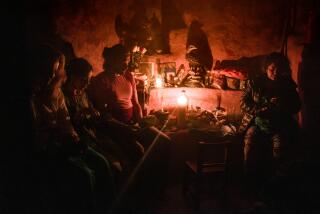Truffles : More varities can be found beneath the woodlands of the Pacific Coast than anywhere in the world
- Share via
KIAH, Calif. — The driver’s signal to slow was given only after the procession of buses and support vehicles had snaked far along a private logging road and well into the Mendocino hills.
The stop, carefully selected by a scouting party days earlier, signaled the start of a most unusual food foray.
Out from the assembled transports poured more than 100 people--all far too enthusiastic considering the damp, dreary weather.
Yet, spirits were fueled by the anticipation of being among the first ever to forage Northern California’s prime timberland for the jewel of fungi: the domestic white truffle.
Prized for a sensual aroma and equally exotic taste, similar European truffles sell for as much as $300 a pound. But there is a perception, particularly among food elitists, that the famous underground bulbs grow only in Italy and France. Not so.
More varieties of these spore-filled morsels can be found beneath the woodlands of the Pacific Coast than anywhere in the world, according to an impressive array of botanical scientists on hand for the expedition.
These experts, and other interested parties, were brought together to celebrate this surprising news and other fungus-related developments at the 2nd Western Truffle Congress. The hunt crowned the conference, coming after two days of seminars, exhibits and truffle-laced foods.
But after sitting through quite enough slide shows on the what/where/why of this elusive, below-ground mushroom, the convention-goers relished a chance to try their hands at finding a few.
Such intentions were ambitious, but not misplaced. Over the past five years a fledgling, domestic truffle trade has emerged--as an offshoot of the $21 million wild mushroom industry. However, the Pacific truffles that have surfaced in commerce are all from Oregon and Washington.
Northern California, on the other hand, is a mostly unknown truffling entity.
Thus, the field trip’s prime objective was to unearth the most popular of the domestic truffles, a species known as the Oregon white, here in the woodlands of Mendocino.
Popular Among Chefs
In the past year, the Oregon white, of the many Western varieties identified, has proven the most popular among American chefs and food fanciers. Those few brokers with access to the golf ball-size fungi are now selling about 1,500 pounds annually, with projections that this total will ultimately increase to as high as 5,000.
John Ash, a leading California chef and owner of a Santa Rosa restaurant that bears his name, is enthusiastic about the development. Having prepared a gala dinner for the conference using several different species of truffles, Ash said that the Oregon white is the most delicate of the lot with an aged, musky, redwood scent.
One decided advantage of the U.S. version, Ash said, is that its cost is a fraction of the more renowned European varieties--at $65 a pound.
Even discounted, though, the cost of truffles is staggering considering they are used, basically, as bold seasoning. The price is set by virtue of scarcity.
The lack of any commercial cultivation means that the fungi must be literally unearthed by expert collectors. Its typical habitat is a hidden one, underneath layers of dead leaves, a couple inches of top soil and, maybe, a smattering of twigs. And at that, only a few wooded areas can be considered reliable hunting grounds from year to year. To be successful requires patience, knowledge of the forest and a good back.
All this trouble, though, is warranted, according to devotees.
Used sparingly, the truffle imparts an earthy, yet wonderful, taste to foods. The mere addition of a truffle shaving to, say, a pasta dish, soup or a pork roast is cause for celebration at many of the best tables.
Legendary Fragrance
And the tuber’s pervasive fragrance is legendary. One oft-repeated anecdote involves eggs. To maximize the perfume, chefs will often place a dozen, uncracked eggs in a bowl with a truffle overnight. The next day, when the eggs are cooked, well apart from the fungi, each will offer up a much enhanced flavor--the truffle’s gaseousness having penetrated the eggshells with ease.
So, the news that a facsimile of the European truffle is plentiful in this country’s forests is causing quite a stir in culinary quarters.
Nor is the interest provincial, as judged by the recently concluded truffle congress. Adding academic luster to the meeting were botanists from as far away as Sweden, France and Mexico. But most of the learned were scientists from the Pacific Northwest, who are pioneering much of the research on truffles and other wild mushrooms. Foremost among these is Oregon State’s James Trappe, Ph.D.
“There is no good, hard information on truffle hunting, a lot of it is art. And my training is as a scientist, not as an artist. So, I may use a lot of weaselly words to describe what we’re doing here,” said Trappe, who has spent 30 years researching and lecturing about the key relationship between fungi and trees.
With Trappe’s lead, the trufflers broke into several small groups, well equipped with hand rakes for digging and wax paper bags to store any underground specimens. All ambled over barbed wire fencing and down onto sloping hillsides into the midst of a towering Douglas fir forest.
This particular tree is the focus of the hunt because it alone acts as the host for the domestic fungus systems that produce the precious Oregon white bulbs. These systems are much like subterranean grapevines, the fruit of which is the truffle.
This subtle connection is actually the sidelight of research into accelerated tree growth. Many of the scientists present claim that the truffle-producing fungus systems grow in tandem with trees and help facilitate the flow of nutrients, minerals and water to the firs.
“This is all very important,” said Trappe. “Fungi of this kind are absolutely necessary for the survival of trees. (Through understanding the relationship) we are working toward better management of our forests and the simultaneous production of edible fungi.”
Not wanting to sound too didactic, Trappe turned his attention to an unearthed nodule, inspecting one through a jeweler’s eyepiece.
“I think we’ve got a little one here,” he announced.
“Oh, shoot. It’s not a truffle. Well, I’ve always been good at crushing hopes. . . . This, in fact, looks like an old decrepit piece of . . . elk dropping.”
Looking to one of his colleagues, Trappe said, “It’s not luck, it’s skill.”
There are several guidelines on finding an Oregon white truffle, according to Trappe. Namely, rake about three to four inches into the earth on the northwest side of the fir tree; start to dig several paces from the trunk, and watch for squirrel diggings. (Small animals are also attracted to the fungi.)
Even with all the tips, experts and proper forestation, some in the party lamented the absence of the dogs or pigs who accompany Europeans on similar ventures. However, training the keen smelling animals has been low on the list of the scientists’ research priorities. Besides the pigs, for one, are more interested in eating the truffles they find than yielding the culinary treat to their masters, they said.
After being hunched over, gnome-like, for several hours, it became apparent to participants that the digging was not going well. Several secondary species, known as false truffles, were found, but no jewels, per se. In fact, many in the group unearthed nothing but ground cover.
A consensus arose, among the botanists, that the lack of truffles could be blamed on 1987’s quirky weather and the lack of rain.
“In the Northwest, and Northern California, we had a severe drought this year. There were no September rains,” said Mike Castellano, Ph.D., with the U.S. Department of Agriculture’s Forest Service. “By November, we had some rain, but the delay in moisture slowed the metabolism of the fungus down. A development like this occurs once in a century.”
With only several wild mushrooms in hand, the buses loaded up and headed back through the hillsides to compare the meager finds at an apres-hunt party at Geyser Peak Winery, one of the event sponsors. There was some talk that an actual Oregon white was found, but none ever materialized at the reception.
Undaunted, most in the group pronounced the Truffle Congress a success.
“I think I did see two small truffles somewhere,” Trappe said. “And so, they do, indeed, occur in this area. And by no means is this trip a bust. It’s been very successful even without a find--if that’s the case.”
A first-time truffler echoed Trappe.
“This whole thing was super,” said Larry Stroud of Sebastopol. “I’ve been hunting wild mushrooms for 15 years and never bothered to go after a truffle because I didn’t think there were any. I did find one of those false truffles today. It’s not as good as the real thing, but now I know what to look for. It was a minor thrill.”
Others preferred to put the day’s meager haul in historical perspective, claiming that all the attention devoted to truffles, and the like, is good for their long-neglected passion.
“Yes, the study of mushrooms and fungus is an excursion into obscurity. And I guess that’s especially true of truffles because you don’t even know they exist unless you dig for them,” sighed Frank Evans, a member of the North American Truffling Society and co-author of a truffle cookbook. “Part of the reason is that mushrooms in our culture are not held in a position of trust as they are in Europe. I mean, we just recently got beyond this uniquely American fear of toadstools. So, after today’s excursion, truffles, even though they’re underground, might become a subject of great interest to some people.”
More to Read
Sign up for Essential California
The most important California stories and recommendations in your inbox every morning.
You may occasionally receive promotional content from the Los Angeles Times.













